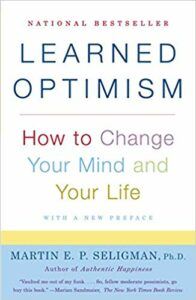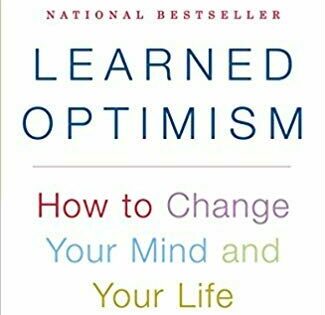This post contains affiliate link(s). An affiliate link means I may earn advertising or referral fees if you purchase through my link.
“Learned Optimism: How to Change Your Mind and Your Life” by Martin E.P. Seligman, Ph.D. explores the differences between optimists and pessimists, how those differences affect each of them, and how to be a flexible optimist so you can bring about greater results in your life.
With flexible optimism, you can be an optimist almost always and pessimistic on those rare occasions when that would be beneficial.
In “Learned Optimism,” Seligman extensively reveals research he has conducted in his career as a leader in practical and positive psychology. Psychology explores our thinking and how that affects every area of our lives.
Through this book review of “Learned Optimism,” I’ll tell about some of the immense value contained within Martin Seligman’s ABCs of flexible optimism. You’ll have the opportunity to learn more about yourself and others, and to apply learned optimism to your daily life.
Differences Between Optimists and Pessimists
“Pessimists … tend to believe bad events will last a long time, will undermine everything they do, and are their own fault. The optimists … think about misfortune in the opposite way. They tend to believe defeat is just a temporary setback (and) that its causes are confined to this one case. … Such people are unfazed by defeat. Confronted by a bad situation, they perceive it as a challenge and try harder.” – Martin Seligman
With that quote, Seligman provides the context for what he will cover throughout “Learned Optimism.” It could be said that optimists live by faith and pessimists live by fear. One is healthier than the other, but there are times when fear can be helpful and even a lifesaver. That being said, indulging in too much fear leads to a severely limited life.
“Pessimists give up more easily and get depressed more often.” – Martin Seligman
I enjoyed learning about the many experiments and studies that Seligman has conducted. He shares his findings and what that means for the reader. These findings are revealed and discussed so we can better understand what it is to be human and what we can do to improve our lives. I enjoy reading practical books, and “Learned Optimism” is definitely practical.
Seligman’s research has shown that optimists do much better as students, workers, and sports players than pessimists do. Optimists believe in themselves much more than pessimists do. Optimists are more likely to get elected for public office than pessimists.
“Optimists … age well. … They may even live longer.” – Martin Seligman
Considering these differences between optimists and pessimists, isn’t it much more beneficial to look on the bright side of life rather than on the dark side?
“A pessimistic attitude may seem so deeply rooted as to be permanent. I have found, however, that pessimism is escapable. Pessimists can … learn to be optimists.” – Martin Seligman
Reread this part of the quote:
“Pessimists can … learn to be optimists.” – Martin Seligman
That statement can easily be considered the book’s theme, and Seligman proves it every chance he gets.
What Is Learned Optimism About?
With learned optimism, you’re learning five letters of a new alphabet as you learn to be an optimist. Each letter stands for something.
- A is for Adversity.
- B is for Belief.
- C is for Consequences.
- D is for Disputation.
- E is for Energization.
A, the Adversity, is whatever trouble/problem/challenge you’re facing. B, the Belief, is whatever you believe about the Adversity. C, the Consequences, are your feelings, actions, and results from your Belief about the Adversity.
As you may have guessed, the letter D, Disputation, is the most important part of learned optimism. This is where you turn things around by learning and applying optimism. You have multiple options for what to do with your pessimistic beliefs. You can distract yourself from them and think about something else. You can dispute your pessimistic beliefs, and this is much more effective. You can also distance yourself from your pessimistic beliefs.
“It is essential to realize your beliefs … may or may not be facts.” – Martin Seligman
When you apply Disputation, you’re disputing your negative beliefs and showing yourself that optimism makes much more sense. Disputation is where you learn to be an optimist. This is where you transform yourself from being pessimistic to being an optimist. You can use Disputation in any of the following four ways:
- Evidence
- Alternatives
- Implications
- Usefulness
“The most convincing way of disputing a negative belief is to show that it is factually incorrect. You will often have facts on your side since pessimistic reactions to adversity are often overreactions. You adopt the role of a detective and ask, “What is the evidence for this belief?”” – Martin Seligman
With evidence, you gather evidence for why you have the beliefs that you do. Does the evidence support having negative beliefs? The answer tends to be a resounding “No!”
For alternatives, you’re looking for alternatives to your negative beliefs.
“Ask yourself, “Is there any less destructive way to look at this?”” – Martin Seligman
Become skilled at generating alternatives to your negative beliefs. That gives you a chance to see things for how they are and not for how bad they might appear to be.
For implications, here’s what to do when a negative belief might be accurate. Ask yourself, “Even if my belief is correct, what are its implications?” Once you have identified the implications, ask yourself, “How likely are those awful implications?” After you’ve answered that question, search again for evidence for that negative belief.
With usefulness, you’re examining if it’s useful for you to have a particular belief. If a belief is helpful in a healthy way, it’s useful. However, if a belief is harmful, it’s not useful, and you can work on dismantling it and letting it go.
Once you’ve applied D, Disputation, you get to E, Energization, which results from moving past your negative beliefs. You energize yourself and shine new light upon your life. You liberate yourself and allow yourself the chance to see the giant that you are.
Here is an example of learned optimism…
Example of Learned Optimism
Adversity: I’m not working on my projects even though I have the time available to do so.
Belief: I’m helpless, and the situation is hopeless.
Consequences: I avoid working on my projects and permanently transforming my life for the better. Thus, I have more of the same, and it looks like I’m stuck.
Disputation: I’ve seen that I can get things done. I’ve sometimes surprised myself with what I’ve achieved. I choose to believe in myself and take concrete actions. I choose to work on my projects and schedule accordingly. I am capable, and the situation is solvable.
Energization: I now work on my projects and am starting to permanently transform my life for the better. I am getting unstuck. I feel positive about myself and my progress. I enjoy working on my projects and am happy I’m giving them the attention they deserve. I’m so happy that I’m allowing my dreams to come to life.
That’s one example. The book “Learned Optimism” provides additional examples to review as you apply learned optimism.
Applying Learned Optimism
Since Disputation is where you switch from pessimism to optimism, you can keep a Disputation Record to track your progress. Seeing your progress in writing helps you continue building the flexibility to be an optimist instead of a pessimist.
“Practice the ABCDE model. … During the next five adverse events you face, listen closely for your beliefs, observe the consequences, and dispute your beliefs vigorously. Then, observe the energization that occurs as you succeed in dealing with the negative beliefs and record all of this. These five adverse events can be minor. … In each of these, use the four techniques of effective self-disputation. … Do it in your daily life over the next week. Don’t search out adversity, but as it comes along, tune in carefully to your internal dialogue. When you hear … negative beliefs, dispute them. Beat them into the ground. Then record the ABCDE.” – Martin Seligman
As a reminder, the ABCDE is Adversity, Belief, Consequences, Disputation, and Energization. And the four techniques of effective self-disputation are evidence, alternatives, implication, and usefulness.
Go ahead now. Pick five adverse events over the next week and keep a Disputation Record tracking how you deal with any negative beliefs that arise in your life.
Here again is what I consider the theme of the book “Learned Optimism:”
“Pessimists can … learn to be optimists.” – Martin Seligman
You can do this. You can fully face life as it really is and not how your fears paint it to be. Your life, circumstances, and the world are brighter than you think.
Conclusion
In “Learned Optimism,” Seligman provides the ABCDE framework for creating optimism out of pessimism. Learned optimism is possible, and you can apply the ABCDE framework and share your results in the comments section below.
There is plenty of value to be found throughout the book “Learned Optimism,” including a discussion about the link between pessimism and depression. I had a great time reading the book, and I enjoy letting you know about excellent resources like it.
In “Learned Optimism,” Seligman also shares about specific times of day when you are more vulnerable to being pessimistic. That part of the book shows enough reason to sleep in until at least 5:00 a.m., if at all possible.
I used to have a job where I started work at 5:00 a.m. I woke up at 4:00 a.m. to get ready for work, and now I know why I was so unhappy at that time of day besides being seriously sleep-deprived. I had an extremely difficult time falling asleep back then.
Buy “Learned Optimism” and apply the ABCDE framework to your life. You’ll get to dispute your negative beliefs and let them go. And I’m excited for you for that.
You are greater than you think, stronger than you know, and more powerful than you realize.
Thank you for reading. Here is what else you can do:
-
- Add any questions or comments you have in the comments section below;
- Subscribe so you can be notified by e-mail when I add another post on this website; and
- Share this post, including on social media.
Until next time,
James Barnett

Hello James,
I really enjoyed reading this book review. It looks like a great book to read. I like to be optimistic. There is always lots of room for improvement.
Thanks for this shining a light on this topic. Our outlook on life effects us all the time.
You are like the captain on a ship steering the ship in the right direction. Sometimes there are tricky areas and it takes the expertise and experience of a seasoned captain to pilot the ship safely through. You are like a captain, and your ship is your website. The passengers are your readers. Your help and calm direction helps your readership become more seaworthy on the seas of life!
Hello Maisie,
Yes, “Learned Optimism” is a great book to read. In the book, our outlook on life is referred to as our explanatory style. Things happen, and we each have a style for explaining what those things mean for us and for our lives. There are positive interpretations, and there are negative interpretations. The positive interpretations are typically a lot more helpful, productive, and accurate than the negative ones.